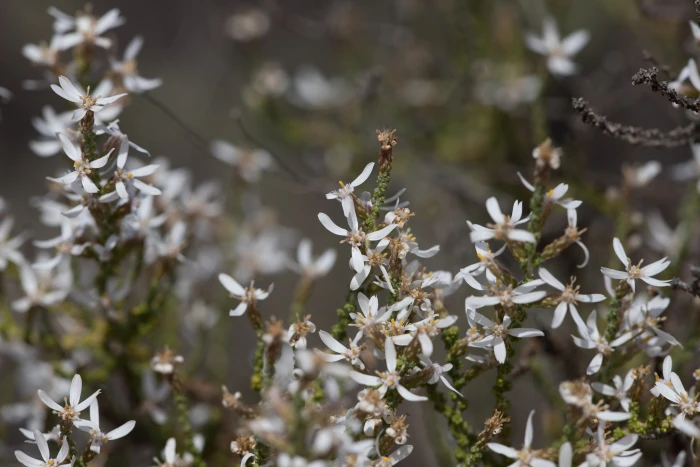Club-Moss Daisy-Bush
(Olearia lepidophylla)
Club-Moss Daisy-Bush (Olearia lepidophylla)
/
/

© Kym Nicolson
CC BY 4.0
Image By:
© Kym Nicolson
Recorded By:
Copyright:
CC BY 4.0
Copyright Notice:
Photo by: © Kym Nicolson | License Type: CC BY 4.0 | License URL: http://creativecommons.org/licenses/by/4.0/ | Uploader: knicolson | Publisher: iNaturalist |









Estimated Native Range
Climate Requirements for Deer Park, New York
| This Plant | Your Site | Plant Suitability for Your Location | ||
|---|---|---|---|---|
| • Precipitation | 7" - 84" | 42" | Aquatic | Aquatic |
| • High Temp. | 61°F - 100°F | 82°F | Your summer temperatures are normal for this plant. | Excellent |
| • Low Temp. | 24°F - 49°F | 24°F | Your winter temperatures may be too cold for this plant | Too cold |
This plant may not grow well at your location - your precipitation is too high.
Summary
Olearia lepidophylla, commonly known as club-moss daisy-bush, is a shrub endemic to a variety of habitats including mallee, heathlands, and coastal sand dunes across southern Australia. It typically grows up to 4.9 feet tall with a similar spread, featuring oblong to egg-shaped leaves. From March to June, it produces white and yellow daisy-like flowers that are modest in size but can be quite numerous, creating a noticeable display.
Club-moss daisy-bush is appreciated for its hardiness and the textural contrast its foliage provides in the garden. It is often used in native plant gardens, as a low hedge or in mass plantings for erosion control on slopes and sand dunes. It prefers full sun to part shade and is tolerant of a range of soil types, provided they are well-drained. While it is drought-tolerant once established, it benefits from occasional watering during prolonged dry periods. There are no major disease or pest issues, but it may require pruning to maintain shape and encourage denser growth.CC BY-SA 4.0
Club-moss daisy-bush is appreciated for its hardiness and the textural contrast its foliage provides in the garden. It is often used in native plant gardens, as a low hedge or in mass plantings for erosion control on slopes and sand dunes. It prefers full sun to part shade and is tolerant of a range of soil types, provided they are well-drained. While it is drought-tolerant once established, it benefits from occasional watering during prolonged dry periods. There are no major disease or pest issues, but it may require pruning to maintain shape and encourage denser growth.CC BY-SA 4.0
Plant Description
- Plant Type: Shrubs
- Height: 6-8 feet
- Width: 6-8 feet
- Growth Rate: Moderate
- Flower Color: White
- Flowering Season: Summer
- Leaf Retention: Evergreen
Growth Requirements
- Sun: Full Sun, Part Shade
- Water: Medium
- Drainage: Fast, Medium
Common Uses
Border Plant, Low Maintenance, Showy Flowers
Natural Habitat
Endemic to mallee, heathlands, and coastal sand dunes across southern Australia
Other Names
Common Names: New Zealand Holly
Scientific Names: Olearia lepidophylla , Aster lepidophyllus , Aster microphyllus , Diplostephium lepidophyllum , Eurybia lepidophylla , Eurybia lepidophylla var. lawrencei , Eurybia lepidophylla var. lepidophylla , Eurybia microphylla , Shawia lepidophylla
GBIF Accepted Name: Olearia lepidophylla